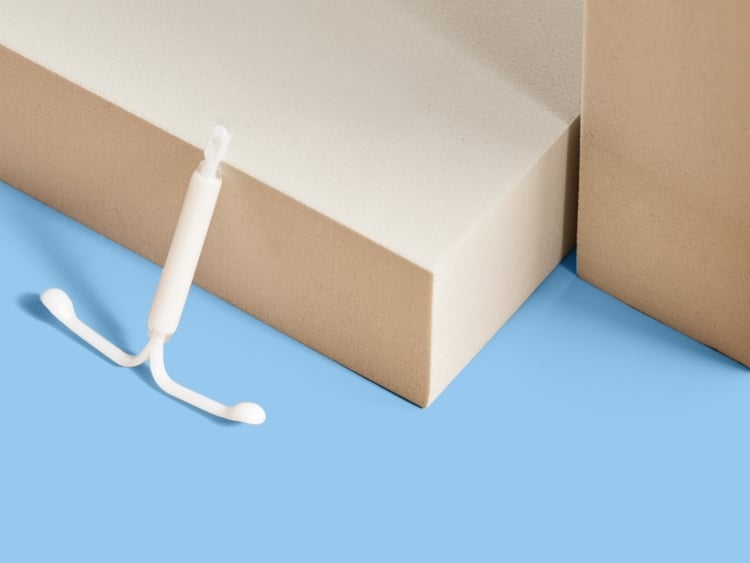Interested in getting an IUD? Here’s your complete guide to IUD insertion, side effects, and what to do if yours falls out.
-
Tracking cycle
-
Getting pregnant
-
Pregnancy
-
Help Center
-
Flo for Partners
-
Anonymous Mode
-
Flo app reviews
-
Flo Premium New
-
Secret Chats New
-
Symptom Checker New
-
Your cycle
-
Health 360°
-
Getting pregnant
-
Pregnancy
-
Being a mom
-
LGBTQ+
-
Quizzes
-
Ovulation calculator
-
hCG calculator
-
Pregnancy test calculator
-
Menstrual cycle calculator
-
Period calculator
-
Implantation calculator
-
Pregnancy weeks to months calculator
-
Pregnancy due date calculator
-
IVF and FET due date calculator
-
Due date calculator by ultrasound
-
Medical Affairs
-
Science & Research
-
Pass It On Project New
-
Privacy Portal
-
Press Center
-
Flo Accuracy
-
Careers
-
Contact Us
IUD Expulsion: What To Do If Your IUD Falls Out


Every piece of content at Flo Health adheres to the highest editorial standards for language, style, and medical accuracy. To learn what we do to deliver the best health and lifestyle insights to you, check out our content review principles.
The number of women and people who menstruate who use an IUD (or coil) has increased dramatically in the last decade. And it’s no surprise — IUDs are incredibly effective at preventing pregnancy and require little maintenance.
Read on for our guide to getting an IUD and what to do if yours falls out (also known as “expulsion”). Remember: Your health care professional is the best first point of contact for all things contraception, so book an appointment as a starting point.
Take a quiz
Find out what you can do with our Health Assistant
What is an IUD?
Let’s start with the basics: An intrauterine device (IUD) or coil is a small, T-shaped device that is placed inside the uterus to prevent unplanned pregnancy. There are two different types to choose from: a non-hormonal IUD that’s covered in copper and a hormonal IUD that releases progestin (a synthetic form of the hormone progesterone).
IUDs have become hugely popular for people who use contraception, in part because they’re hassle-free, long-lasting, and 99 percent effective at preventing pregnancies when professionally inserted. It’s a win-win-win situation.
How does an IUD work?
The two types of IUDs may look similar, but they actually work in pretty different ways.
A non-hormonal copper IUD works by releasing copper ions, which repel sperm and keep them from reaching an egg.
On the other hand, a hormonal IUD prevents pregnancy in several ways. It thins the lining of your uterus, which makes it harder for a fertilized egg to attach, and it thickens the mucus around your cervix (the lower end of the uterus), making it harder for sperm to get through. On top of all that, the progestin released by the IUD also stops ovulation, meaning your ovaries won’t release an egg that could potentially be fertilized. The hormonal IUD is also approved by the Food and Drug Administration (FDA) for treatment of heavy menstrual bleeding. Pretty cool.
Why do IUDs have strings?
If you’ve ever seen an IUD, you’ve probably noticed the two small pieces of string dangling from the bottom. Those strings are actually an essential part of the IUD’s design. They help you check that your IUD is in place and help the doctor remove it when the time comes. Think of them like the strings on a tampon.
What’s IUD insertion like?
IUD insertion starts off like many trips to the gynecologist. To begin, a nurse or doctor will ask you about your medical and sexual history. They might also perform a pelvic examination, which might include using a swab to collect a sample of cervical cells. If this is the case, your doctor should explain the examination beforehand so you understand what it entails and can fully consent.
Then, they’ll use a speculum to gently open the walls of your vagina and a tool called a tenaculum to stabilize the cervix. Before they can insert the IUD, they’ll need to measure your uterus so that they can insert the IUD correctly. Then they’ll use another tool to guide the IUD into the uterus. When the IUD reaches the correct depth (indicated by uterine sound), the IUD is pushed out of its tube and allowed to open into the “T” shape you’re familiar with. Stabilizing the cervix, measuring the uterus, and inserting the IUD can all cause cramping. For some people, it’s a walk in the park, but for others, it can hurt quite a lot (but only very briefly!). Some doctors recommend taking a pain reliever before your appointment, just in case.
How can I expect to feel after an IUD insertion?
Your body is unique, so how you feel after an IUD insertion might vary a lot from how someone else feels. You might not feel any side effects at all, or you might experience IUD cramps or backaches. Spotting is also a common side effect. All of these sensations are completely normal.
Additional side effects depend on what kind of IUD you had inserted. If you had a copper IUD inserted, then your period might get heavier and your cramps more intense. Alternatively, if you opted for a hormonal IUD, you might have lighter periods or find your period stops altogether. Again, this is normal.
What if I can feel my IUD strings coming out (or can’t feel them at all)?
Now, IUDs are pretty reliable — that’s why so many people opt for them. But hey, things happen, and your IUD could fall out. If your IUD’s strings feel longer or shorter than usual, or you can’t feel the strings at all, it’s possible that your IUD has moved or fallen out. But don’t freak out: It’s also possible that the strings have folded on themselves and simply aren’t within reach or that the IUD has moved a little higher.
The only way to be sure is to make an appointment to get it checked out. Just remember that, generally speaking, if your IUD has moved or been expelled, then it won’t prevent pregnancy. If it’s shifted to a lower part of your uterus, then it may still be effective. However, if you suspect it’s moved, it’s a good idea to consult your doctor. Until your appointment, you should use a backup form of birth control (such as condoms) while you wait for your doctor to give you the all-clear.
These are some signs your IUD has moved or been expelled:
- Discomfort during sex
- A change in menstrual bleeding
- Increased cramping

Why has my IUD moved or been expelled?
While most IUDs never move, IUD expulsions (when IUDs fall out) do occur in 2–10 percent of patients. And it’s quite easy to see why they happen when you consider that the uterus is a muscle that contracts.
Dr. Barbara Levy, Clinical Professor of Obstetrics and Gynecology at the George Washington University School of Medicine and Health Sciences (and Flo Medical Board member), explains that “for some, this muscle contracts very, very firmly.” That’s often when expulsions happen because the uterus contracts around the IUD and pushes it toward the cervix.
As logic follows, people with heavy bleeding or heavy cramping or people who might have an uneven uterine surface might be more likely to expel their IUD. In these cases, the muscles are either contracting harder than usual or aren’t able to hold the IUD in place, she says.
According to Dr. Levy, another factor that can determine whether you might be more likely to expel your IUD is if your body has a greater production of prostaglandin, which is the chemical that causes the uterus to contract.
That said, people who are most likely to have their IUDs fall out are patients aged 14–19 years.
Can an IUD fall out without you knowing?
It’s rare, says Dr. Levy, but it’s possible to pass your IUD through a blood clot — without even realizing it — if you’re someone who has a very heavy flow. The key word here is “rare.”
Generally, if your IUD falls out, you’ll feel the plastic or the strings of the IUD or experience some cramping. “It’s more likely that you’ll feel some symptoms associated with the expulsion,” says Dr. Levy.
How can I check if my IUD is still in place?
To check that your IUD hasn’t prematurely left your uterus or moved, you should try to regularly check your IUDs strings in the first few months after it’s been inserted. Just remember not to pull on the strings, or you could accidentally remove it yourself!
To check if your IUD is still in place, wash your hands, squat or sit down, then slowly insert a finger into your vagina. You might not feel the strings right away, in which case, you might want to reach a little higher. If you still don’t feel the strings, then schedule an appointment with your health care professional to make sure everything is in the right place. And again: Just be sure to use another method of contraception (such as condoms) until you get the all-clear.
What happens if my IUD isn’t in my uterus?
If you’ve checked for strings and gone to a doctor for an ultrasound, and you and your doctor still can’t locate your IUD, then the next step might be to do an X-ray. Perforation of the uterus with an IUD is extremely rare, but it does happen. Given just how rare it is, though, Dr. Levy recommends not worrying too much about the possibility.



Hey, I'm Anique
I started using Flo app to track my period and ovulation because we wanted to have a baby.


The Flo app helped me learn about my body and spot ovulation signs during our conception journey.


I vividly
remember the day
that we switched
Flo into
Pregnancy Mode — it was
such a special
moment.
Real stories, real results
Learn how the Flo app became an amazing cheerleader for us on our conception journey.
References
“Intrauterine Devices (IUDs): Access for Women in the U.S.” KFF, 9 Sept. 2020, www.kff.org/womens-health-policy/fact-sheet/intrauterine-devices-iuds-access-for-women-in-the-u-s. Accessed 10 Nov. 2021.
Zimmerman, Rachel. “CDC Report Tracks The IUD Renaissance | WBUR News.” WBUR.Org, 12 Nov. 2015, www.wbur.org/news/2015/11/12/iuds-health-report. Accessed 10 Nov. 2021.
“Intrauterine Devices (IUD).” US Library of Medicine, medlineplus.gov/ency/article/007635.htm. Accessed 10 Nov. 2021.
“Long-Acting Reversible Contraception (LARC): Intrauterine Device (IUD) and Implant.” ACOG, www.acog.org/womens-health/faqs/long-acting-reversible-contraception-iud-and-implant. Accessed 10 Nov. 2021.
“Clinical Challenges of Long-Acting Reversible Contraceptive Methods.” ACOG, www.acog.org/clinical/clinical-guidance/committee-opinion/articles/2016/09/clinical-challenges-of-long-acting-reversible-contraceptive-methods. Accessed 10 Nov. 2021.
Madden, Tessa, et al. “Association of Age and Parity With Intrauterine Device Expulsion.” Obstetrics & Gynecology, vol. 124, no. 4, 2014, pp. 718–26. Crossref, doi:10.1097/aog.0000000000000475. Accessed 10 Nov. 2021.
“Intrauterine Device (IUD).” Nhs.Uk, 10 Nov. 2021, www.nhs.uk/conditions/contraception/iud-coil. Accessed 10 Nov. 2021.
“Deciding about an IUD.” U.S. National Library of Medicine, medlineplus.gov/ency/patientinstructions/000774.htm. Accessed 10 Nov. 2021.
Johnson, Brett. “Insertion and Removal of Intrauterine Devices.” American Family Physician, 1 Jan. 2005, www.aafp.org/afp/2005/0101/p95.html. Accessed 10 Nov. 2021.
“Intrauterine Device (IUD) | University Health Service.” University of Michigan, uhs.umich.edu/contraception-iud. Accessed 10 Nov. 2021.
Madden T, McNicholas C, Zhao Q, Secura GM, Eisenberg DL, Peipert JF. Association of age and parity with intrauterine device expulsion. Obstet Gynecol. 2014 Oct;124(4):718-726. doi: 10.1097/AOG.0000000000000475. PMID: 25198262; PMCID: PMC4172535.




